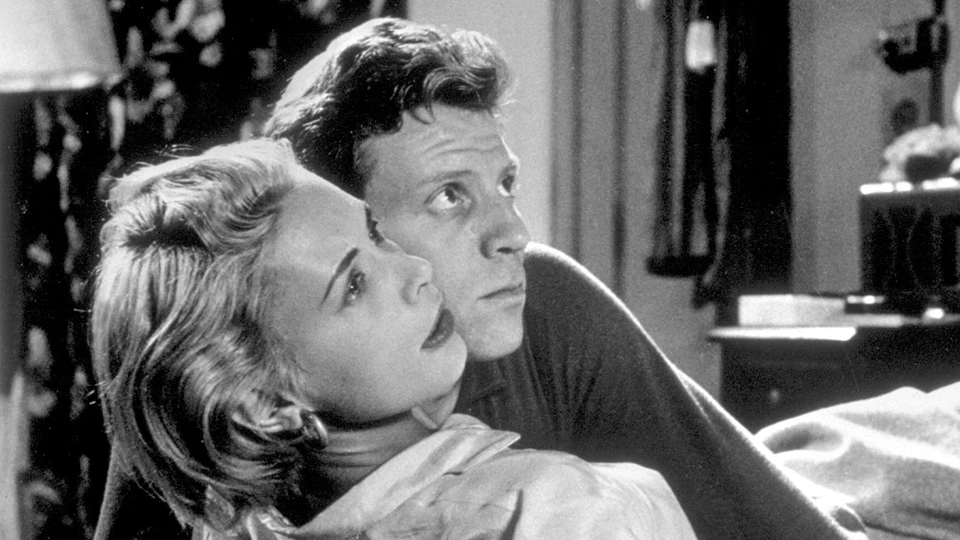Killer's Kiss

Stanley Kubrick’s sophomore feature tells the story of a boxer who falls for his neighbor and runs afoul of her gangster boss. An uneven effort, it nonetheless shows flashes of brilliance.
Jamie Smith plays the boxer, named Davey Gordon. The film opens with him smoking and pacing in New York City’s Penn Station. In what will become an unfortunate theme, we get voiceover narration.
A quick note about the production: After struggling to make the sound work early, Kubrick fired his soundman and opted to add all the dialog and sound effects in post-production. This begs the question: was all the voiceover narration present in the original script, or did Kubrick add it as a workaround?
Anyway, Davey’s narration leads to a flashback, framing the film.
We learn Davey’s an aging boxer about to fight in a make-or-break bout against a younger, up-and-coming talent. He lives in a small apartment. Across the courtyard lives a young woman named Gloria, played by Chris Chase. The pair take turns eyeing one another, unaware the other is also stealing glances. They leave their apartments, Davey for his fight, and Gloria for work.
Waiting to pick up Gloria, we meet her boss, played by Frank Silvera. His smarmy tone alerts us to his shady nature, and when it’s revealed he owns a taxi-dance hall in Times Square, we buy it.
Meanwhile, on the way to his bout, Davey reads a letter from his uncle. More voice-over narration, this time cringe-worthy in its artifice. Davey loses the bout and resolves to move back home to Seattle.
Later that night, screams rouse Davey from sleep. Through the window, he sees a man assaulting Gloria in her apartment. We recognize the man as her boss. Davey rushes over, going upstairs and over the roof as it’s the fastest route. Gloria’s boss flees, but not before getting a look at Davey and recognizing him.
Davey stays with Gloria, standing guard. The next morning, she tells Davey how she came to the city and her job as a taxi dancer. More voice-over narration over a semi-flashback within a flashback. The pair spend the day together. Romance blooms. Gloria agrees to leave town with Davey, but her boss has other ideas.
It’s a decent-enough setup marred by the execution. Smith looks the part of a boxer, and acquits himself well in the fight sequence, which Kubrick imbues with a visceral fury, highlighted by a sequence where he cuts between a close shot, wider shots, and then a POV shot, as Davey takes a blow to the face and the camera pans up at the bright lights as he collapses on the mat.
But Smith struggles with the voiceover. He lacks the charisma to carry such large swaths of dialog. Worse still, I’m not convinced the narration is even necessary. Kubrick shows us everything we need to know.
As Gloria, Chase fares better. She’s all cheekbones and nails early. Allure tinged with a vulpine hint of danger. She handles her voice-over narration with comparable ease—except it’s not her. Chase wasn’t available to record her lines, so radio actress Peggy Lobbin voiced the role.
Regardless, it’s Kubrick’s visual talents that elevate the picture. Shooting on location, Kubrick casts New York as a labyrinth of dead-end alleys, bustling streets, and cramped apartments. He leverages Times Square’s garish marquees and window displays to establish the seamy atmosphere. For the finale’s big chase sequence, he first leverages the wide but desolate back alleys of Hell’s Hundred Acres to convey a sense of futility, framing Smith as a tiny ant caught in a monstrous maze. Then, when Smith ascends a series of fire ladders to reach the rooftops, he frames him in a Hitchcockian wide shot, still an ant scurrying atop a vast roofscape, with the Manhattan Bridge looming in the hazy distance.
Beyond leveraging the city, Kubrick employs other cost-effective visuals, like inverting the black-and-white colors during an effective nightmare sequence for Davey that sees the camera flying down the city streets, or the ominous shot looking down the staircase leading up to the taxi-dance hall, with the “Watch Your Step” sign atop the frame.
Working with the barest of budgets, Kubrick couldn’t afford expensive effects or stunts. When a man jumps out of a freight elevator as it’s descending, it surprises because it’s real. Along those same lines, I appreciated the authenticity following the film’s lone outright stunt. When Davey jumps through a window, he’s dazed for a moment and struggles to his feet. A nice touch of realism.
The film culminates in a now-iconic showdown between Davey and Gloria’s boss in a mannequin factory. Here Kubrick’s editing again shines. As Gloria’s boss grabs an axe and Davey attempts to parry with a spear, Kubrick cuts to shots of dangling, disembodied mannequin hands. Showing us the stakes at play without running afoul of the censors.
Indeed, there’s a lot to unpack in Killer’s Kiss. The dark sets lend a noir feel to the proceedings, but Davey’s farm boy good nature, combined with the disingenuous happy ending, place it closer to The Long Night’s melodrama than Out of the Past’s hard-boiled cynicism.
At just sixty-seven minutes, it doesn’t overstay its welcome, but neither does it feel as tight as it could be. Kubrick was still learning. As director, cinematographer, and editor, he shaped the film to his vision. I won’t hold the ending against him, as United Artists forced it as part of the film’s acquisition, but the needless voiceover hints at Kubrick still being unsure of himself—or at least second-guessing his decision to fire his soundman.
He’d learn from this experience, and build upon hard-boiled and noir-ish overtones with his superior follow-up, The Killing. For Kubrick fans, Killer’s Kiss proves an intriguing experience, but newcomers should start with the director’s later films (like The Killing) first.